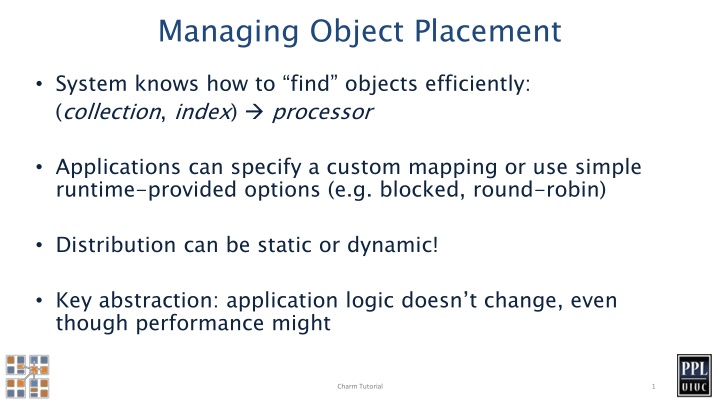
Efficient Object Placement and Management System Tutorials
Learn about managing object placement efficiently, separating application logic from mapping, broadcasting messages, performing reductions, and implementing reduction examples using Charm++ tutorials.
Download Presentation

Please find below an Image/Link to download the presentation.
The content on the website is provided AS IS for your information and personal use only. It may not be sold, licensed, or shared on other websites without obtaining consent from the author. If you encounter any issues during the download, it is possible that the publisher has removed the file from their server.
You are allowed to download the files provided on this website for personal or commercial use, subject to the condition that they are used lawfully. All files are the property of their respective owners.
The content on the website is provided AS IS for your information and personal use only. It may not be sold, licensed, or shared on other websites without obtaining consent from the author.
E N D
Presentation Transcript
Managing Object Placement System knows how to find objects efficiently: (collection, index) processor Applications can specify a custom mapping or use simple runtime-provided options (e.g. blocked, round-robin) Distribution can be static or dynamic! Key abstraction: application logic doesn t change, even though performance might Charm Tutorial 1
Managing Object Placement Application logic development decoupled from any notion of processors or object mapping Separation in time: make it work, then make it fast Division of labor: domain specialist writes object code, CS specialist writes mapping Portability: different mappings for different systems, scales, or configurations Charm Tutorial 2
Broadcast A message to each object in a collection The chare array proxy object is used to perform a broadcast It looks like a function call to the proxy object From the main chare that created a chare array: CProxy_Hello helloArray = CProxy_Hello::ckNew(helloArraySize); helloArray.foo(); From a chare array element that is a member of the same array: thisProxy.foo(); From any chare that has a proxy p to the chare array p.foo(); Charm Tutorial 4
Reduction Combines a set of values: sum, max, concat, Usually reduces the set of values to a single value Combination of values requires an operator The operator must be commutative and associative Each object calls contribute in a reduction Charm Tutorial 5
Reduction: Example mainmodule reduction { mainchare Main { entry Main(CkArgMsg msg); entry [reductiontarget] void done(int value); }; array [1D] Elem { entry Elem(CProxy_Main mProxy); }; } Entry Method Attribute Charm Tutorial 6
Reduction: Example #include reduction.decl.h const int numElements = 49; class Main : public CBase_Main { public: Main(CkArgMsg msg) { CProxy_Elem::ckNew(thisProxy, numElements); } void done(int value) { CkPrintf( value: %d\n , value); CkExit(); } }; Output value: 1176 Program finished. Output class Elem : public CBase_Elem { public: Elem(CProxy_Main mProxy) { int val = thisIndex; CkCallback cb(CkReductionTarget(Main, done), mProxy); contribute(sizeof(int), &val, CkReduction::sum_int, cb); } }; #include reduction.def.h Charm Tutorial 7






















